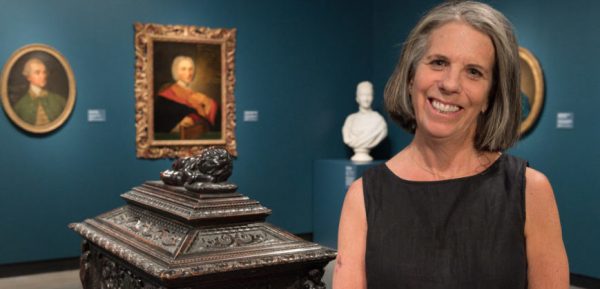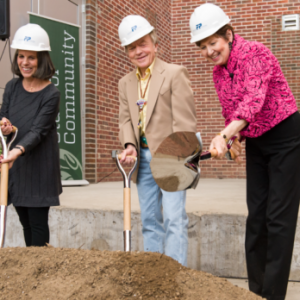
By Tony Phifer
Linny Frickman playfully refers to herself as “the accidental museum director.”
“I never would have imagined myself doing this,” said Frickman, who has been associated with CSU’s galleries and art museums since 1990.
Now, as Frickman counts the last days of her remarkable 29-year career at CSU, there are many who can’t imagine what life will be like without her at the University Center for the Arts. And they certainly can’t imagine what CSU’s museums would look like had Frickman not been bold enough – and determined enough – to turn them into the wondrous spaces now enjoyed by the university and surrounding community.
“Absolutely, the museum we have at the UCA would not be here without Linny,” said Bob Hoffert, a retired former dean of the College of Liberal Arts. “Linny has done so much for the department, the college and the university. She absolutely carried the idea of a university art museum and made it happen.”
Frickman’s CSU story began in 1988 when she landed a job as an adjunct teacher of art history. That’s when she discovered her love for teaching and utilizing art in all its forms to spark inspiration and discussion in her students.
Her career path changed, however, in 1990 when Jim Dormer, then chair of the art department, asked her to take over CSU’s Clara Hatton Gallery. She had art degrees from Oberlin College and the University of Colorado, and a stint working with collections at Houston’s Museum of Fine Arts, and the renowned Menil Collection Museum in Houston, but otherwise had very little training as a gallery director.
At the time, the majority of CSU’s somewhat disjointed collections were stored in two closets in the Visual Arts Building. That’s where her education really began.
In the early 2000s the Department of Art began to think about a true art museum and the need to care for these collections. With the encouragement of Dr. Patrick Fahey, then chair of the Department of Art and Art History, and art history professor Dr. Pat Coronel, Frickman began to organize and catalog collections.
“I have very, very vivid memories of going in there and spending more than a week cleaning out the mouse droppings,” she said. “Our art was very poorly stored, mainly because we didn’t have proper facilities and didn’t have personnel to do those things.”
That began a long labor of love for Frickman who, despite never having a tenured position, made it her goal to put CSU on the arts map.
The big break came in 2005, when a lead gift from Pat Stryker’s Bohemian Foundation gave CSU the boost it needed to to begin the transformation of the old Fort Collins High School into the University Center for the Arts. Space for an art museum was part of the original plan, then got bumped, then made a comeback.
“We had lots of fundamental battles at the time just to include all of music, theatre and dance, and smaller pieces like the museum were going to be left out,” Hoffert said. “Every time we reached a crisis in funding, Linny and the museum were on the chopping block, but she never lost her focus or commitment; she held things together and found ways to succeed.
“In the end, in order for us to have a true university arts center, it had to include a space for the visual arts. If you just look at the plans on paper, Linny was one of the most peripheral components of the project, but in reality she was one of the two or three most central people.”
Securing the space for the museum was just one issue. To be truly recognized as a noteworthy university museum, Frickman needed a noteworthy collection to display. Enter the Hartford-Tandstad Collection of nearly 200 works of art.
The Hartford-Tandstad collection, valued at $1.5 million, was donated by Fort Collins residents Larry Hartford and Torleif Tandstad. It includes an eclectic mix of pieces, including several notable works by European artists.

Frickman, named museum director in 2009, said careful planning made acquiring the gift possible. Further, it required extended spaces for exhibition and storage of the collection. The new space included climate-controlled display areas and storages – essential for any successful museum.
“People in the art community noticed that we were passionate about properly caring for our pieces,” Frickman said. “Clearly, getting the (Hartford-Tandstad) collection was huge. It allowed us to really raise the bar and to bring in smaller, but no less significant collections from other donors.”
Hoffert said Frickman played a central role in acquiring the collection, revealing that Hartford and Tandstad originally had different plans for the destination of the collection.
“The way Linny nurtured that relationship to attain that collection was just remarkable,” Hoffert said. “Linny had patience and persistence and let the situation evolve. Not only did we get the gift, but the original receiver was respected and the donors delighted.”
Finally, a $2 million gift from an anonymous donor came in, giving a name to the new museum in 2016: The Gregory Allicar Museum of Art.
Frickman envisioned a space that serves as both a quiet place to view the Hartford-Tandstad, African and Native American collections, as well as travelling exhibitions and rotating exhibitions from other areas of the permanent collection, while also providing educational opportunities to CSU students. In a very short time it has emerged as one of the finest university museums in the region.
True to form, Frickman brushes aside any praise sent her way, focusing instead on the future of the museum. She is spearheading a push to earn accreditation by the American Alliance of Museums and will continue to lead that effort.
In her place, Lynn Boland will take over as director of the Allicar Museum on July 3. He comes from the University of Georgia, where he has been curator of European art at the Georgia Museum of Art.
“Lynn is wonderful,” Frickman said. “I feel like we’ve really accomplished some significant milestones but it’s time for somebody young who can take us to the next phase. This is a good time for me to step aside.”